

 The South African
The South African
by Ken Gillings
South African Military History Society, Durban Branch
Various options were available to Buller after the relief of Ladysmith. These included a western advance across the Drakensberg into the Orange Free State (which would have taken the pressure off Field Marshal Lord Roberts's post-Paardeberg operations); a northern advance through Natal into the eastern Transvaal (which would probably have hastened Roberts's advance on Pretoria because it would have drawn away Boer support from that theatre of the war); and even a combination of both movements. As it was, despite requests from his commanders to follow up on their victory of 27 February, Buller allowed the Boers, demoralised after the failure of their heroic stand against overwhelming odds to prevent the British breakthrough via Pieters, to continue their retreat.
The Boers were accordingly ordered to take up positions between Ladysmith and the Transvaal, and along the Orange Free State border. This they were able to do as a result of several weeks of British inactivity, brought about by Buller's decision to regroup in and around Ladysmith after the relief. Admittedly, his troops and the Ladysmith garrison were in need of rest and recuperation, but certainly not for a period of over three months, as it turned out to be.
Upon redeployment, the Boer line was stretched to its limit. The Free State commandos occupied positions from Oliviershoek Pass to Van Reenen Pass. They were under the command of Hoofkommandant M Prinsloo, who had appealed unsuccessfully to President M T Sleyn for more burghers (Many Free Staters had been withdrawn from the Natal front in an attempt to counter Lord Roberts's advance on Bloemfontein). The Transvalers were positioned from De Beers Pass, along the Drakensberg, to the vicinity of Vryheid. The focal point of their defences was the Biggarsberg range - stretching from the Drakensberg at Cundycleugh as far as Helpmekaar and ending on the heights above the village of Pomeroy, between Dundee and Greytown.
The task of defending the eastern line became the responsibility of General Lucas Meyer, with the Vryheid, Utrecht, Swaziland, Piet Retief, Johannesburg, Krugersdorp and Middelburg commandos under his command. Included in his operational area were the remote districts of Nongoma, Babanango and Nqutu. The Piet Retief Commando was responsible for the key position of Helpmekaar. The other strategically important position along the Biggarsberg was Van Tondersnek Pass, which, in spite of the tendency of the British to move along the railway, was considered to be the logical route for any advance. The Swaziland, Utrecht and Johannesburg commandos were tasked with defending this pass. The Middelburg and Krugersdorp commandos were stationed at Glencoe, also the site of General Louis Botha's headquarters. They were responsible for the defence of Glencoe, as well as for covering the railway via the Biggarsberg. Glencoe was - and remains - an important railway junction. The commandos in Glencoe were supported by the Pretona and Bethal commandos, which were under the authority of General D J E 'Maroela' Erasmus.
The area west of Glencoe was the responsibility of General Schalk Burger (later replaced by General Joachim Fourie). His force consisted of the Carolina and Lydenburg commandos at Biggarsbergnek, the Heidelberg and Standerton commandos at Landmansnek, and the Soutpansberg Commando at Gibsonsnek. General Burger's two remaining commandos, Wakkerstroom and Ermelo, were held in reserve to be used in any eventuality, as were the Irish, German and Italian corps. The Boer strength totalled approximately 10 000 Transvalers along a front which stretched 220 km, and some 3 000 Free Staters extended along a 40 km line and concentrated at two strategic passes.
Buller's initial estimate had placed the number of Boers opposing him at 18 000, a figure which had soared to 25 000 by the third week of March. Shortly after the relief of Ladysmith, General Sir Charles Warren's 5th Division was detached from Buller's force and proceeded to East London for use in operations in the Eastern Cape. While pondering his next move, Buller changed his mind about the route of advance three times in as many days. By the end of March, his military deployment had advanced no further than Thabamnyama in the west and the Sundays River/Elandslaagte area in the north. The only other force of note was that commanded by Lt-Col F C Bethune, which operated in the Pomeroy area. It consisted of 5 Squadron Bethune's Mounted Infantry, a squadron of Umvoti Mounted Rifles, six companies of Imperial Light Infantry, two 12-pounder naval guns and the left section (two 7-pounders) of the Natal Field Artillery. Bethune's task had been to monitor the Boer movements in the Biggarsberg. His troops were involved in a skirmish near Helpmekaar on 8 March. In the meanwhile, Field Marshal Lord Roberts ordered Buller to remain on the offensive until further notice.
Towards the end of March, Buller reorganised his army. General Sir Francis Clery, who had been wounded during the battle of Vaalkrans (5-7 February 1900) returned to duty and assumed command of the 2nd Division from General Neville Lyttelton, who was given command of the 4th Division (consisting mainly of the 7th and 8th brigades from the Ladysmith garrison). General Sir Archibald Hunter was given command of the 10th Division, which comprised General Dart's 5th and General Barton's 6th brigades. Once Warren had departed, General H J T Hildyard was given command of the 5th Division. By then, Buller's army totalled between 25 000 and 30 000 men.
On 27 March 1900, General Piet Joubert died and General Louis Botha was appointed Acting Commandant-General. Command of the Boers in Natal was assumed by Meyer. By April 1900, the number of Boers along the Biggarsberg had shrunk to approximately 6 000 with some accounts claiming a figure as low as 4 500. Had Buller not vacillated, he could have driven through their ranks with very little effort.
On 10 April, the Boers launched a daring raid on the British camp at Elandslaagte, with support from five or six guns. The well-defended British position prevented any forward movement from taking place and the Boers withdrew under the cover of darkness. Minimal casualties were suffered by either side during the engagement. Further operations were restricted to brief skirmishes which also involved the Italians commanded by Captain Camillo Ricchiardi. On 7 May, Ricchiardi launched a night attack on the Elandslaagte coal mine and this action was reported in the Natal Mercury of 10 May under the heading: 'Attack by Italian bandits - False alarm at Buller's camp'!
It was also on 7 May that General Buller announced his plan for the British advance. This involved Clery's 2nd Division undertaking an encircling movement towards the east via Helpmekaar, while Hildyard's 5th Division moved in the direction ot Glencoe, repairing the railway and covering the 2nd Division's left flank. Bethune's force was tasked with covering the 2nd Division's right flank while operating in the Pomeroy/Helpmekaar area.
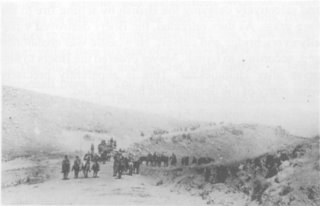
A Boer Commando in the Helpmekaar area

Helpmekaar, Fehruary 1899. Route of advance by Thorneycroft's
Mounted Infantry as they ascended Uithoek, capturing the high
ground almost without a fight. Bethune's Mounted Infantry linked
up from the right. The Boers had concentrated their commondos
at Van Tondersnek Pass, leaving Uithoek and Helpmekaar
weakly defended by the Piet Retief Commando.
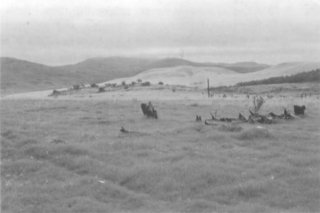
Helpmekaar, February 1899. The British swept up the valley
and captured the high ground in the distance. Bethune's force
linked up from the right
As the British were leaving Vermaakskraal at dawn on 13 May, the Boers directed artillery fire onto them but were silenced by the British naval 4,7-inch guns. Buller immediately realized that if his plan of deception was to succeed, speed would be of the essence. He ordered Dundonald to cover the proposed advance and the troops swept up Uithoek Pass, with Thorneycroft's Mounted Infantry ascending the two features known as Ngcone and Sikhanyisweni, Major John Dartnell's Natal Volunteers the hills to the west, and Bethune, having advanced to within a few hundred metres of Sikhanyisweni, co-operating with his men. Hamilton's brigade moved in support, while Cooper's moved in reserve. Once the heights had been taken the British swarmed up towards the summit of the plateau in the direction of the Piet Retief Commando, who, fearing that they would be enfiladed from their left, leapt from their positions and fled back towards the Helpmekaar ridge. This move did not particularly endear them towards their fellow burghers, who thereafter derisively referred to them as the 'Piet Retreaters'
At Helpmekaar, the Boers put up a spirited resistance, but by the following day they had retreated past Dundee, Col Lynch's Irish Brigade providing some covering fire and effectivelv delaying the British by setting fire to the long grass. As they retreated, the Boers destroyed virtually every bridge and culvert. Newcastle was abandoned and, according to Lynch, Meyer ordered the Boers to disperse after Helpmekaar. This is apparently precisely what many of the demoralised burghers did.
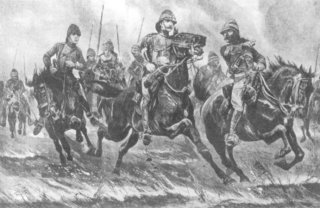
Lord Dundonald's cavalry advances along the Biggarsberg in
pursuit of the Boers who had set the veld alight during this retreat.
Although well planned and well executed, Buller's advance was taking far too long to be of any consequence to Lord Roberts, who by that stage was well on his way towards taking Pretoria.
On 19 May, Buller planned the next stage. The Boers had crossed the Drakensberg at Lang's Nek (more recently known as Laing's Nek) Those who could be persuaded to remain had established well concealed trenches on either side of the pass. Realizing this, Buller decided to create the impression that Lang's Nek was his target, rather than his true objective - Botha's Pass.
The 4th Brigade and the 1st West Surrey Regiment (detached from the 2nd Brigade) were ordered to form the advance guard. They marched to Ingogo (or Schuinshoogte) where they bivouacked for nine days. Their camp could be clearly observed by the burghers from their positions at Lang's Nek.
Hildyard's division was tasked with repairing the railway line. On 26 May, Lyttelton's division swung eastward from the Ngagane River, outside Newcastle, to link up with Hildyard at Utrecht, which was held in some strength by Gen Grobler. Lyttelton's division commenced clearing the Doornberg to the south-east near Landman's Drift, while Hildyard reached Utrecht on 29 May. (Note: At the time, Utrecht was in the Transvaal Republic). After a considerable amount of discussion, the landdrost formally surrendered the town, the Boers taking up a position on the hills above it in return for the assurance by the British that Utrecht would not be shelled if they remained there! The Transvaal flag and six rifles were taken away as a sign of submission and Buller's proclamation of surrender by the town was posted up.
Hildyard had hardly left Utrecht before the Boers returned, re-occupied the town, tore down the proclamation and arrested the landdrost who had surrendered. Despite the comical aspect of this incident, it proved once again how adept Buller's commanders were at wasting time. He had halted in Newcastle for no less than sixteen days and had, in effect, moved no further than Ingogo and Utrecht.
Meanwhile, having cleared Christiaan Botha's force from the Doornberg, Lyttelton moved his division northwards and advanced parallel to Hildyard's, going into camp at Coetzee's Drift on the Mzinyathi (Buffalo) River from 2 until 12 June, thereafter advancing as far as Wakkerstroom in the eastern Traasvaal which he captured on 13 June. It is at this stage that we shall leave Lyttelton and return to Buller and the remainder of the Natal Army.
It may be recalled that during the vacillation following the relief of Ladysmith, Lord Roberts eventually gave up any hope of co-operation from Buller and informed him by telegram on 25 May that he could manage without him. Roberts suggested to Buller that once he had decided upon his next move, he was to advance on Belfast in the eastern Transvaal and cut off the Delagoa Bay Railway Line.
On 29 May, Buller wrote to Christiaan Botha, who was in command at Lang's Nek (Gen 'Maroela' Erasmus, Meyer's successor after his appointment as commandant of Pretoria, having travelled to the capital). Buller told Botha that he believed that the situation for the Boers was hopeless and suggested a cessation of hostilities. As a result of the telegram, Botha rode down to below Lang's Nek under a flag of truce. Buller, accompanied by Clery, pointed out to him that Roberts had advanced as far as Germiston, that the fall of Pretoria was inevitable, and that further resistance by the Boers would be a waste of life which he was anxious to prevent, especially since a number of the burghers opposing him were old friends of his. Botha naturally requested assurance from Buller that he was authorised to make the proposal for the cessation of hostilities. Incidentally, neither Buller nor Botha had such authorisation. Nonetheless, Buller proposed that the Boers disperse to their farms, leaving behind their artillery but taking their rifles. A final decision regarding the surrender of arms would be taken when peace was announced! Fortunately for the Boers, Buller was unaware that they were totally demoralised, numerically stretched to the limit, and facing large-scale desertion. He was still under the impression that he was faced by a determined foe, but was heartened by the news of Roberts's capture of Elandsfontein and its resultant threat to the northern Transvaal heartland, which exacerbated desertion amongst the Boer forces.
The meeting of Buller and Botha ended with both parties agreeing to a three-day armistice. During this time, their proposal was conveyed to Lord Roberts on the one hand and the Boer government on the other. While waiting for the replies, both sides enjoyed a few quiet days, during which they edged themselves into more favourable fighting positions in the almost inevitable event of a deadlock. A few days later a reply came from Lord Roberts. His terms were unconditional surrender, the Boer rank and file being required to give up their arms and horses after which they would be allowed to return to their homes only if they agreed not to fight again in the war. The officers would be kept on parole.
On 5 June 1 900, Roberts entered Pretoria, setting the scene for the next stage of the main theatre of the war. On the same day, Christiaan Botha informed Buller that his terms had been unacceptable to the government and the armistice ended with salvos being fired by the British gunners.
Meanwhile, while Lyttelton bivouacked at Coetzee's Drift on his right flank, Hildyard moved his division to De Wet's farm, south of the Schuinshoogte ridge, where he was joined by the 2nd Brigade. On 6 June, General Brocklehurst's 2nd Cavalry Brigade linked up with him. The scene in Natal was now set for Buller's next move. His options were to move via Lang's Nek, involving a frontal attack against an apparently well-defended Boer position, or to undertake a flanking movement to the east or west. The former would have presented him with difficult terrain, whereas the latter was the shorter route (via Botha's Pass) to Volksrust. He opted for the latter.
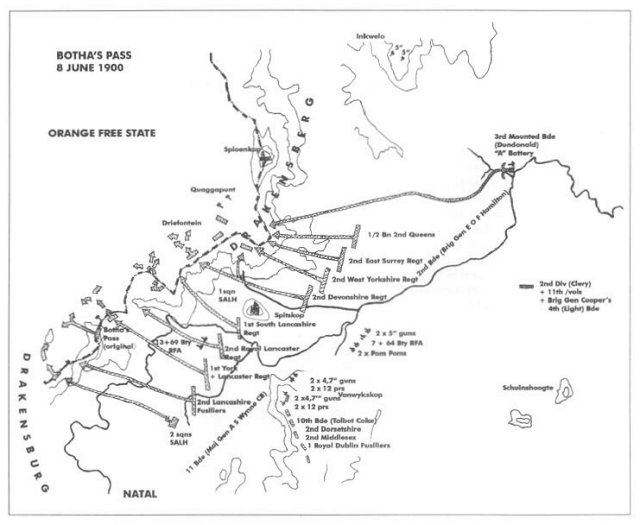
On 6 June, Hildyard was ordered to reconnoitre Van Wykskop. He tasked this to the South African Light Horse (which had been allocated to his division for the Utrecht operations), the 13th Battery Royal Artillery, and the Middlesex Regiment from General Talbot Coke's brigade.
The SALH occupied Van Wykskop with minimal or position, but the Boers at Botha's Pass realized immediately the threat that they posed and tried to retake the position. They moved towards Sweetwaters Farm in the south-west and set fire to the veld. Lt-Col Byng of the SALH had positioned his men along the north-western crest of Van Wykskop, with a front of approximately 5 km.
Hildyard realized that he would have to turn his reconnaissance into a full-scale operation if he wished to secure the high ground. Thus he ordered the Middlesex Regiment to ascend Van Wykskop while the remainder of the brigade was ushered forward from the brigade headquarters at De Wet's farm, a short distance back along the road to Newcastle. The Middlesex Regiment battled for several hours and the Boers only withdrew at about nightfall. A decision was then taken by the British to position some long-range guns on the summit. Upon observing the site, one does not require much imagination to realize the difficulties that this plan posed; it took the Naval Brigade the entire night to drag a 12-pounder up to the summit. The carriage of another gun was broken in the attempt. During the action the Boers opened fire with their Long Tom, which they had positioned on the summit of Phokweni. The range was approximately 10 000 yards (9 144 m), and the projectiles' trajectory took them almost over the heads of Brig-Gen Cooper's 4th Brigade, which had been deployed on Nkwelo.
On 7 June, the British concentrated their forces in preparation for an attack on Botha's Pass. Maj-Gen Talbot Coke's 10th Brigade occupied Van Wykskop; Maj-Gen Wynne's 11th Brigade and the 2nd Cavalry Brigade under Maj-Gen Brocklehurst (with the 5th Lancers, 18th Hussars and 19th Hussars) moved to Geelhoudboom Farm on the eastern side of Van Wykskop; Lt-Gen Sir Francis Clery was left ini command of the outpost lines in front of Ingogo (or Schuinshoogte) with his 2nd Division. He also had with him the Natal Volunteers under the command of Major John Dartnell, and Brig-Gen Cooper's 4th (Light) Brigade.
The heavy artillery was distributed in order that the entire Boer position was covered: Two 5-inch guns were placed on the south spur of Nkwelo, while the remaining two were positioned on the farm Roodepoort, overlooking the banks of the Ngogo River, commanding the approaches to both Lang's Nek and Botha's Pass. To their left, the 7th and 64th batteries Royal Artillery, and two 'Pom-Poms' were deployed to give support to Brig-Gen E O F Hamilton's 2nd Brigade. Then, two 4,7-inch naval guns, two 12-pounders manned by the Royal Garrison Artillery, and two 12-pounders of the Naval Brigade were deployed on a low spur below the north-eastern corner of Van Wykskop. Incredibly, two 4,7-inch and two 12-pounder guns of the Naval Brigade were dragged to the summit of Van Wykskop itself.
Clery's 2nd Division and Hildyard's 5th Division each provided a brigade for the actual assault on the Drakensberg - Wynne's 11th Brigade on the left, and Hamilton's 2nd Brigade on the right. Artillery support for the latter was to be provided by the 7th and 64th batteries, while the 13th and 69th batteries, positioned between Spitskop and the road to the pass, would support the former.
One squadron of the SALH was ordered to occupy Spitskop, while the remaining two would cover the left of Wynne's advance. Lord Dundonald's 3rd Mounted Brigade was tasked with providing support for the infantry's right flank. The cavalry would receive artillery support from 'A' Battery Royal Horse Artillery, 'The Chestnut Troop'.
The Boers had occupied the top of the escarpment from the south of the pass to Nkweloane/Spioenkop. They had positioned some field guns and 'Pom-Poms' at intervals along a broad front. Apparently the main body was provided by the Lydenburg Commando, assisted by a few hundred men from the Carolina Commando. They probably totalled no more than 2 000 burghers.
At 10.00 on 8 June 1900, the British heavy guns opened fire, and the SALH occupied Spitskop without opposition. The infantry brigades formed up in echelon from the right, enabling them to roll up the Boer positions and at the same time to conform with the shape of the hills ahead of them.
At 11.45, Gen Wynne's brigade commenced its advance; it was deployed in echelon formation between Spitskop and Darwin Farm, on the low ground. Shortly afterwards, Hamilton's brigade advanced to form up on the low ground between the Ngogo River and Heuningkrans Farm on the left, and north of the Botha's Pass/ Ngogo roads (on the farm Rietspruit) on the right.
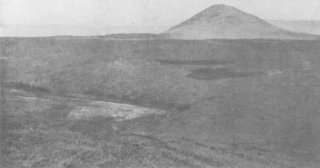
Men from Maj Gen Wynne's 11th Brigade (probably the
Lancashire Regiment) prepare to advance out of the Ngogo
River. Spitskop is prominent in the distance. Botha's Pass
is located left of Spitskop.
The Boers had also dug some trenches along the ridge where the Drakensberg juts into KwaZulu-Natal. These trenches faced southwards, indicating that they had not expected to be attacked from that point. Dundonald's mounted men had, however, ascended the Drakensberg from behind this feature, and Thorneycroft's Mounted Infantry and the composite regiment of mounted infantry reached the summit at about the same time as Hamilton's brigade. They then brought forward the Colt gun battery, a 'Pom-Pom' and two guns of 'A' Battery RHA, which were used to enfilade the Boer trench.
The Boers' resistance lasted for less than thirty minutes. They then set fire to the veld and used the smoke to cover their withdrawal. Brocklehurst's 2nd Cavalry Brigade was moved to the top of the pass at approximately 16.00 and the troops advanced a few kilometres westward. They were, however, unable to make any contact with the Boers who had simply vanished and they returned to the top of Botha's Pass. It rained during the night and Private Tucker wrote in his diary that it was intensely cold. The infantry bivouacked at the top of the pass, experiencing a bitterly cold night, especially since they had been unable to pack their greatcoats. On the other hand, the mounted troops were sent down to the foot of the pass.
For Buller, the most important aspect of the successful outcome of the battle was that he had managed to gain a foothold in the Free State and finally break out of Natal. His strategy at Helpmekaar, where he used revolutionary tactics in deception, were repeated on a far wider scale in his operations below the Drakensberg. These tactics were very similar to those used later in the First World War. Could it be claimed that they were inspired by these operations?
The Boers had remained convinced that Buller would repeat the mistakes made by Gen Sir George Pomeroy Colley at Lang's Nek in 1881 and this notion had been given some credence by Hildyard's futile foray to the east and by the concentration of Lyttelton's division at Coetzee's Drift. These movements gave the Boers the impression that the main British thrust would be via Lang's Nek.
Casualty figures have always been an issue of doubt in the study of the Natal campaign. Prof Breytenbach records that the British lost two men killed and one officer and twelve men wounded and Erasmus writes that the Boer casualties were four burghers lightly wounded. Mr Steve Watt, who has undertaken extensive research into South African war graves, lists the British casualties as three killed: Pte J Pollecutt (2nd Middlesex Regiment), killed on 6 June during the Van Wykskop operation, and Ptes M Flanagan (2nd West Yorkshire Regiment) and J Duffy (1st South Lancashire Regiment), both of whom died during the battle on 8 June. It is interesting to note that Buller's casualties after Ladysmith were a fraction of those incurred before the Relief.
After the battle, the Boers took up a defensive position along the Versamelberg range, through which the road to Volksrust passes via a gap known as Allemansnek. Many of the Transvalers had left their positions at Lang's Nek to join Louis Botha in the vicinity of Pretoria. Their numbers totalled between 1 200 and 1 300 burghers, still mainly from the Lydenburg and Carolina commandos.
The British, on the other hand, spent 9 June moving guns and supply wagons up Botha's Pass, a task which was only completed on the following day. Clery was kept in the vicinity of Schuinshoogte in anticipation of Buller's next move. On 10 June, Buller advanced into the Free State. Standing at the top of the original pass, one can easily detect the direction of the original tracks into the Free State - one swings south-westwards and the other towards the north-west. Buller followed the latter track, to which the present road links up as it proceeds to the Free State/Mpumalanga border at the confluence of the Gansvlei and Klip rivers. He established his camp in this vicinity, some 15 km from Botha's Pass. During the afternoon, two squadrons of the SALH (which formed the advance guard) encountered some Boer scouts who had occupied Gansvleikop. A fierce fight ensued, with the burghers advancing to within 40 metres of the British. Only the timely arrival of the 19th Hussars and some artillery support prevented a disaster for the British, whose casualties in this action were six killed and ten wounded. The Boers lost six killed and three wounded.
The stage was set for Buller's next move, which was to try to break through the Boer line at Allemansnek. He believed that this would involve either rolling up the Boer line along the Versamelberge, or attempting to break through the nek itself. He chose the latter option. Gen Chris Botha had requested Erasmus to send reinforcements, which arrived on 9 June. These included some 250 burghers from the Pretoria and Bethal commandos and 200 from Standerton, but Erasmus was faced with so many desertions from his positions at Lang's Nek that he, in turn, requested reinforcements from Bethal and Standerton. By 10 June, Botha's front was approximately 12 km in length. He had two 'Pom-Poms' and two field guns deployed in well-concealed positions straddling Allemansnek. It is quite likely that the Boer gunners had secured beforehand the ranges of likely British gun positions and infantry lines. The accuracy of their fire in the ensuing battle seems to support this theory. Botha's main problem, however, was that he was occupying too wide a front with insufficient numbers of men. He set up his headquarters on the nek near Rustfontein, Gen Piet Joubert's farm, while Gen Joachim Fourie was tasked with defending Allemansnek itself.
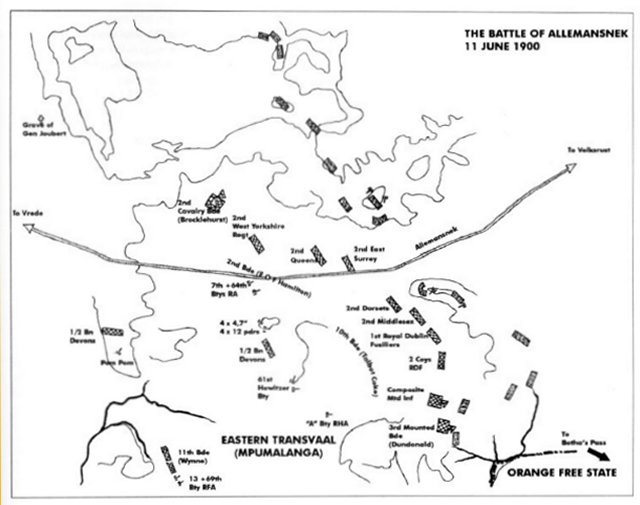
At 05.30 on 1 June 1900, Dundonald advanced until he was approximately 5 000 metres from the entrance to the nek, while Boer skirmishing parties harassed him from that direction. His men could clearly observe the burghers strengthening their positions by entrenching on either side of the nek.
At 10.00, 'A' Battery RHA was brought into action, but the Boer gunners only responded approximately an hour later. The heavy artillery was then brought into position, and orders were given to the brigade commanders to prepare to advance. Talbot Coke's 10th Brigade was ordered to attack the eastern side of Allemansnek, and Hamilton's 2nd Brigade the left. Wynne's 11th Brigade was kept in reserve with the 13th and 69th batteries RA. For some reason or another, the heavy artillery only opened fire at about 13.00, and Dundonald then commenced his movement to the right. He was fired upon by the Boers who had occupied the hills ahead of him.
Some 12 km away to the left, Brocklehurst's 2nd Cavalry Brigade made contact with the extreme right flank of the Boer line in the vicinity of Zoetendalsvlei farm, and by 13.30 all the British guns were in action and shelling the high ground of the Versamelberg range.
The infantry only commenced advancing at 14.30 - some eight hours after Dundonald's initial contact had been made with the Boers - in an attack which had been scheduled to commence at 13.45.
From the British point of view, Hamilton's brigade was faced with a formidable barrier of high ground. The Queen's (The Royal West Surrey Regiment) formed up on the right of Brocklehurst's cavalry brigade. On their right came the 2nd East Surrey Regiment, with the West Yorkshire Regiment and half a battalion of the Devonshire Regiment in support (the other half remaining with the heavy artillery). Coke placed the Dorsetshire Regiment on the right flank of the East Surrey Regiment. Their task was to secure possession of the prominent conical kopje at the entrance to Allemansnek, while eight companies of the Dublin Fusiliers were in turn tasked with a flanking movement to the right of the Dorsets. The Middlesex Regiment was placed in support between the Dorsets and the Fusiliers.

Allemansnek battlefield, February 1999. Boer guns were positioned as follows:
one on either side of the peak right of centre
and two on the high ground on the right (refer to map).
The prominent kopje on the right was the Dorset's objective.
As the infantry advanced, the well-concealed Boer artillery opened fire, accompanied by very heavy rifle fire from the equally well-hidden and well-entrenched burghers. Of greater concern to Buller, Hildyard and their staff were the opening rounds fired by the Boer guns which were accurately directed onto their position, a prominent knoll upon which the heavy artillery had been deployed. The Boer gunners then turned their attention to the advancing infantry, and while the ranging was accurate and the rate of fire heavy, the British surge simply could not be checked.
Dundonald's 3rd Mounted Brigade edged its way in the direction of the Boers' left flank. Thorneycroft's Mounted infantry and the composite regiment of mounted infantry commanded by Lt-Col Hubert Gough came under extremely heavy fire from the burghers who were well entrenched on the high ground ahead of them. As the Dublin Fusiliers advanced towards their objective, they also came under fire from the same spur, and six companies instinctively swung right in order to counter it. The remaining two continued with the advance on their objective.
As the intensity of the Boer attack increased, the Dorsets hastened their pace. The veld ignited, and the south-westerly wind blew the smoke in the direction of the Boers, effectively screening the advancing infantrymen from their sight. The men were ordered to fix bayonets and the Dorsets rushed forward to take the conical kopje at the entrance to the nek, but without any flanking support from the Dublin Fusiliers. This move provided them with a clear view of the entrance to the nek and despite the small size of the kopje, it afforded them good cover from the Boer marksmen.
Due to the topography on the left of the British attack (ie, the Boers' right flank), Hamilton's brigade was unable to advance as rapidly as the other and the East Surrey Regiment in particular came under devastatingly heavy fire from the Boers, who had good protection against the British artillery from behind the conical kopje.
The most critical stage of the battle had been reached by that stage. The Boers had managed to hold up the British infantry's advance due to their concentration on either side of Allemansnek and from the summit of the hills on either side. As the burghers observed the success of their comrades on that flank, they began to converge, and the Boer rifle fire became more intense. This, in effect, temporarily halted the British advance, since they found themselves in a serious predicament due to lack of cover.
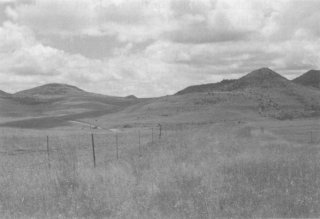
Allemansnek battlefield, February 1999. A closer
view of the objective of the Dorsetshire Regiment,
the prominent kopje on the right.
Almost simultaneously, the 2nd Queens and the 2nd East Surreys cleared the right of the Boers' position on the western end of the nek, and the frustrated infantry poured an ineffective rifle fire in the direction of the retreating burghers, who once again made maximum use of veld fires to cover their withdrawal.
Dundonald's brigade, it will be recalled, had been on the receiving end of heavy small arms fire from the burghers on the left of the Boer position, resulting in the six companies of the Dublin Fusiliers being drawn away from their objective. The advance of the British right flank had ground to a halt. Then the Boers realized that their centre had given way, the mounted brigade having forced them back to some sangars along the main ridge. They then had no option but to abandon these and retreated behind the escarpment of the Versamelberge.
The British casualties in the battle of Allemansnek were officially recorded as 19 killed and 123 wounded. The 10th Brigade suffered heavier casualties than the 2nd Brigade on their left. Sixty-four of the brigade's 91 casualties were suffered by the Dorsets, due to their more vulnerable position coupled with their headlong charge through the nek.
Once again, Boer casualty figures have been difficult to confirm. In a telegram to President Paul Kruger on 12 June, Botha reported that his burghers had fought hard against staggering odds for some twelve hours: 'The enemy suffered heavily ... Our losses are unknown. As far as I am aware, 3 bodies have fallen into the hands of the enemy ...' According to the War Graves records from 11 June 1900, one Boer was buried on the farm Koringplaas and two on the farm Zoetendalsvlei. The latter two were recently reburied on Koringplaas. Most of the Boer casualties were from the Lydenburg Commando and only one is recorded from the Wakkerstroom Commando. Botha noted that seven members of his Swaziland Commando were wounded.
Most of the British soldiers who were killed in the action have been re-interred in the Volksrust 'Garden of Remembrance'.
By the time the rest of the British troops had moved forward, it had become quite dark. It takes little imagination to appreciate how the wounded must have suffered in the freezing cold of a Highveld winter's night, when it was very difficult to locate and remove them from the battlefield.
Buller made no attempt to follow up his victory that night. After forcing his way through Allemansnek, he was at last out of the mountainous terrain of northern KwaZulu-Natal and the north-eastern Free State. He was, in fact, almost in the rear of the main Boer position at Lang's Nek - not even 15 km away. Had he decided to advance that night, it is clear, with hindsight, that he would have wreaked havoc with the already demoralised and diminished remnants of the Boer army along the old Natal/Transvaal border. He would also probably have cut off the railway line which provided the Boers with their access to the interior and, furthermore, by ordering Clery to advance via Lang's Nek at the same time, he would probably have captured most of the Boers' transport and possibly even their guns. In short, Buller could have completely immobilised the Boers. But Buller did not move.
The Boers abandoned their positions at Lang's Nek, withdrew their Long Tom from Phokweni during the night, and retreated to link up with various Boer command structures in the Transvaal. A short, sharp rearguard action was fought against the SALH on 12 June as they advanced towards Volksrust. This was no doubt a delaying tactic to enable the rest of the commandos to withdraw.
On the same day, Maj John Dartnell advanced from Schuinshoogte with the Natal Volunteers and found Lang's Nek deserted. He was followed by Clery with the 4th Brigade and the nek was occupied.
On 13 June, Gen Wynne's brigade moved to Volksrust - the first town in the former Transvaal to be occupied by the Natal Field Force. After Lang's Nek had been occupied, Lyttelton's division, which had been at Coetzee's Drift, advanced up Mollshoogte and, in turn, occupied Wakkerstroom with virtually no opposition.
The Boers had partially destroyed the Lang's Nek railway tunnel by placing a truckload of dynamite in the middle and sending in a train from either side. This action caused a week's delay in restoring rail traffic and, ultimately, the British supply route.
As Buller slowly made his way north-eastwards, the Colony of Natal remained largely devoid of Boer activity. It was defended by some 15 000 men - Lyttelton's division, Brig-Gen Burn-Murdoch's cavalry brigade (the 1st Royal Dragoons, the 5th Dragoon Guards and the 13th Hussars), the Natal Volunteers (who were not allowed to operate outside the Colony), and some fifty guns. While Lyttelton was placed in command of the north, Maj-Gen Wolfe Murray controlled the lines of communication southwards from Newcastle and Col Downing of the Royal Artillery was in charge of the Drakensberg defences. The stage was set for Buller's role in that last set-piece battle of the Anglo-Boer War - the battle of Berg-en-Dal, on 27 August 1900.
Bibliography
Amery, L S, (ed), The Times History of the War in South Africa, Vols III and IV,
(Sampson Low, Marston & Co, London, 1905, 1906).
Barnard, C J, Gen Louis Botha op die Natalse Front, 1899-1902, (Balkema, Cape Town, 1970).
Barthorp, Michael, The Anglo Boer Wars, 1815-1900, (Bok Int for Blandford Press, Manzini. 1988).
Breytenbach, J H, Die Geskiedenis van die Tweede Vryheidsoorlog, Vols III and VI (Staatsdrukker, Pretoria, 1969).
Burne, C, With the Naval Brigade in Natal, 1899-1900, (Arnold, London, 1902).
Creswicke, Louis, South Africa and the Transvaal War, (Caxton, London, nd).
Crowe, George MAA, The Commission of HMS Terrible, 1898-1902, (George Newnes Ltd. London, 1903).
Doyle, Conan, The Great Boer War, (Smith, Elder & Co, London, 1902).
Hall, Maj Darrel, Long Tom.
Knox, E B, Buller's Campaign with the Natal Field Force of 1900, (R Brimley Johnson, London, 1902).
Packenham, Thomas, The Boer War, (Weidenfeld & Nicholson, Great Britain, 1979).
Reitz, Deneys, Commando: A Boer Journal of the Boer War. (1929).
The War Memoirs of Commandant Ludwig Krause, Van Riebeeck Society.
Todd, P, & Fordham, L D, Private Tucker's Boer War Diary.
Viljoen, Ben, My Reminiscences of the Anglo-Boer War, (Hood, Douglas & Howard, London, 1903).
Wilson, H W, With the Flag to Pretoria, Vol II, (Harmsworth Bros Ltd, London, 1901).
Return to Journal Index OR Society's Home page
South African Military History Society / scribe@samilitaryhistory.org